As Copa América reaches its semi-final stage, Colombia and Uruguay prepare for a highly anticipated showdown. Colombia’s dynamic attack will face off against Uruguay’s disciplined defence in a match that promises intensity and excitement. Both teams aim for a spot in the final, making this encounter a must-watch for football fans.
In this tactical analysis, we will provide an in-depth analysis of the countries’ current coaching philosophies, the tactical setups of both teams, their tactics in and out of possession, standout players from both sides and what to expect in their semi-final clash.
Coaching philosophies
Uruguay – Marcelo Bielsa’s coaching philosophy
• High Pressing and Intensity: Bielsa’s teams are characterised by their relentless pressing and high-intensity play, aiming to win the ball back quickly and dominate possession.
• Man-Marking System: A key feature of Bielsa’s approach is the use of a strict man-marking system, where each player is responsible for marking an opponent, leading to aggressive and direct on-field battles.
• Dynamic Formations and Positional Play: Bielsa frequently adapts his formations to exploit opponent weaknesses, emphasising the importance of positional play to create passing triangles and maintain team structure.
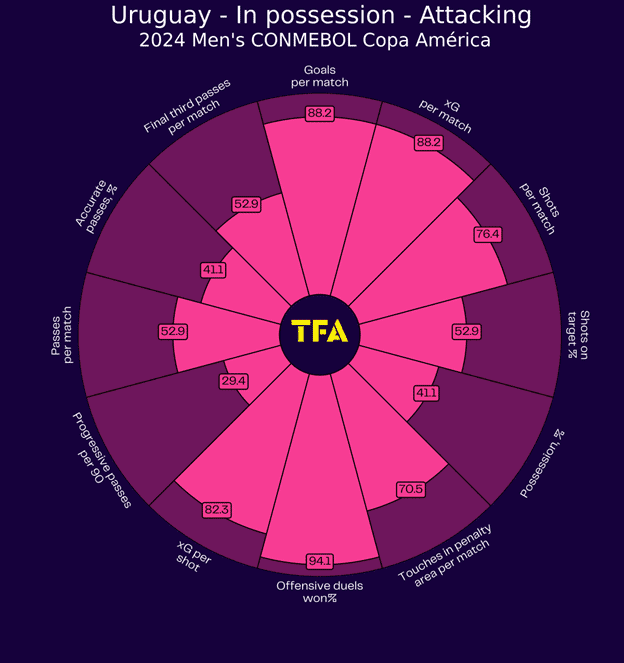
Colombia – Néstor Lorenzo’s coaching philosophy
• Structured Defense and Tactical Discipline: Néstor Lorenzo emphasises a solid, organised defensive structure. His teams are well-drilled in maintaining their shape, making them difficult to break down. He ensures players understand their defensive roles and responsibilities, contributing to a cohesive unit.
• Counterattacking Play and High Press: Lorenzo’s approach often involves a focus on counter-attacking. His teams capitalise on opponents’ vulnerabilities by absorbing pressure and then launching quick, decisive attacks. Speed and efficiency in transition are crucial components of his strategy. His teams employ a high-intensity, high-pressing strategy to disrupt opponents’ build-up play and force turnovers.
• Player Adaptability: Lorenzo strongly emphasises developing players’ technical and tactical abilities. He adapts his tactics to suit his squad’s strengths, fostering a flexible approach that can adjust to various game scenarios and opponents’ strategies.
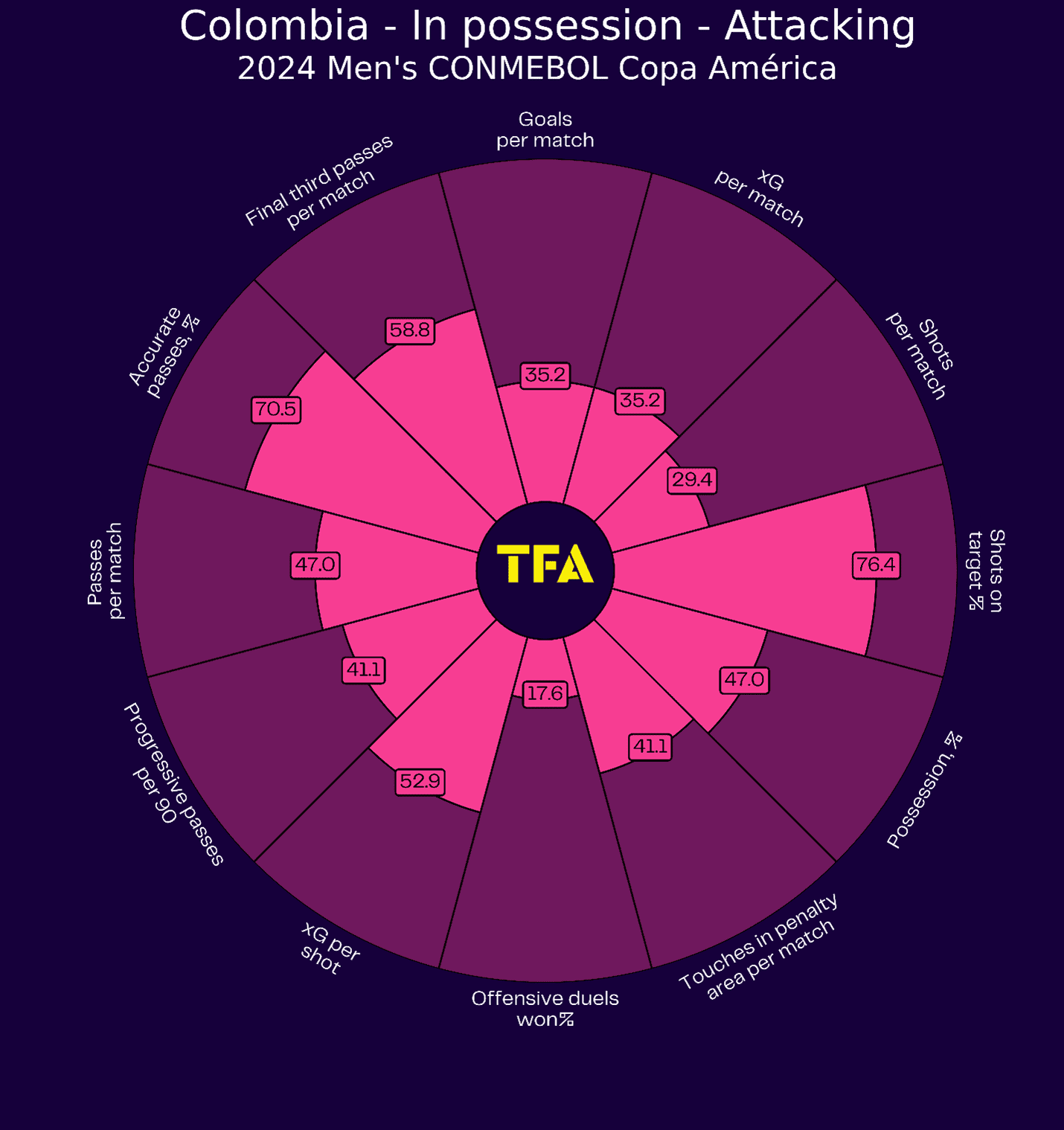
Tactical Setups
Uruguay out of possession
Marcelo Bielsa successfully implemented his signature philosophy into the Uruguayan team, characterised by aggressive man-marking and counter-pressing with a high line. In the first image below, we can see this clearly exhibited: notice how many Uruguayan players are committed forward in regaining possession with high intensity and intent. Similarly, in the second image, this is repeated, with Uruguayan players putting pressure on the Brazilian midfielders and defence as they attempt to build up play.
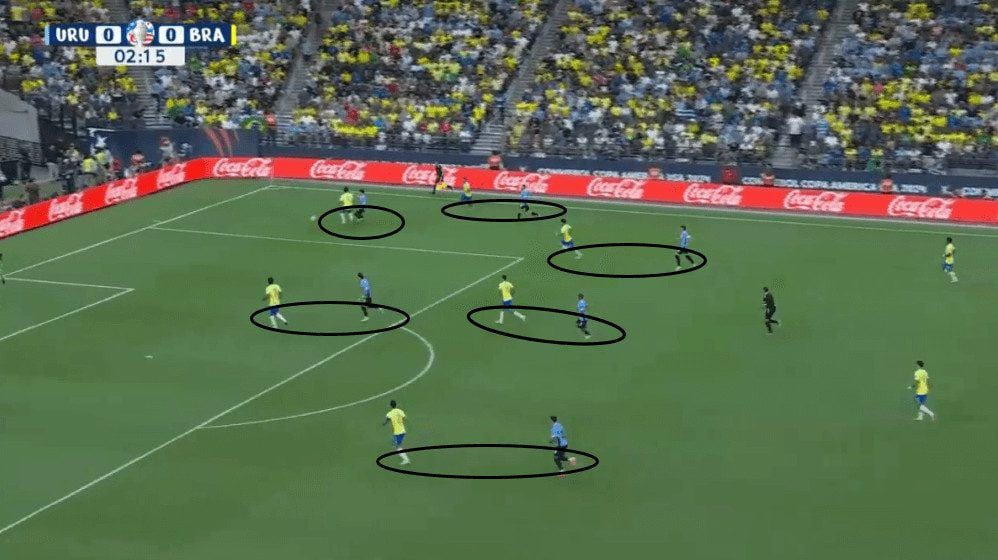
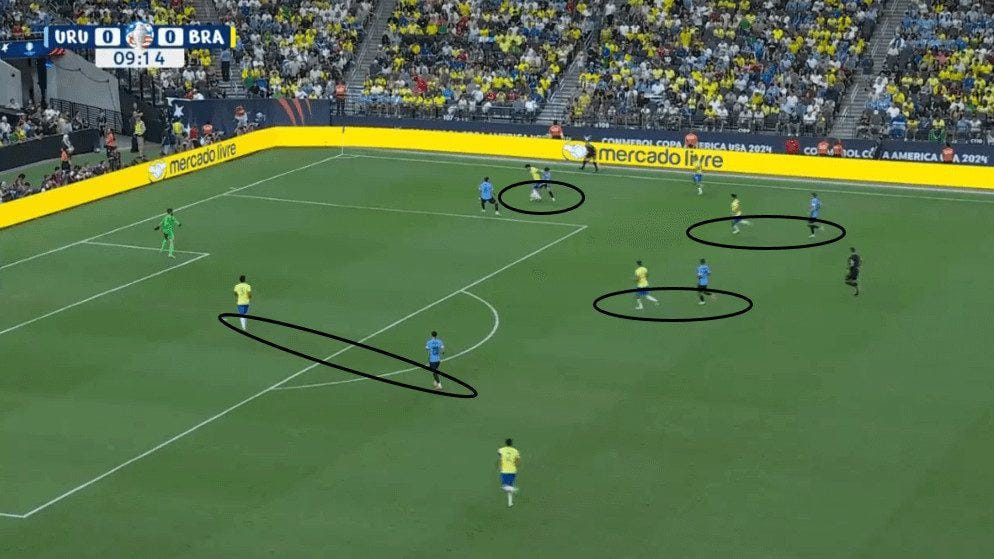
Regarding defensive setup, Uruguay opts to defend in a 4-4-2 or 4-5-1 formation. We can see both structures in the images below, as they are comfortable playing in either. This fluidity is because their high press and man-marking tactics can often leave players out of position. This means their players can’t be perfectly set up in just one defensive structure; instead, they have to rotate between both. In image 1, we can see the 4-5-1 structure, while in image 2, we see the 4-4-2 structure, as Uruguay had more time to set up their players correctly.
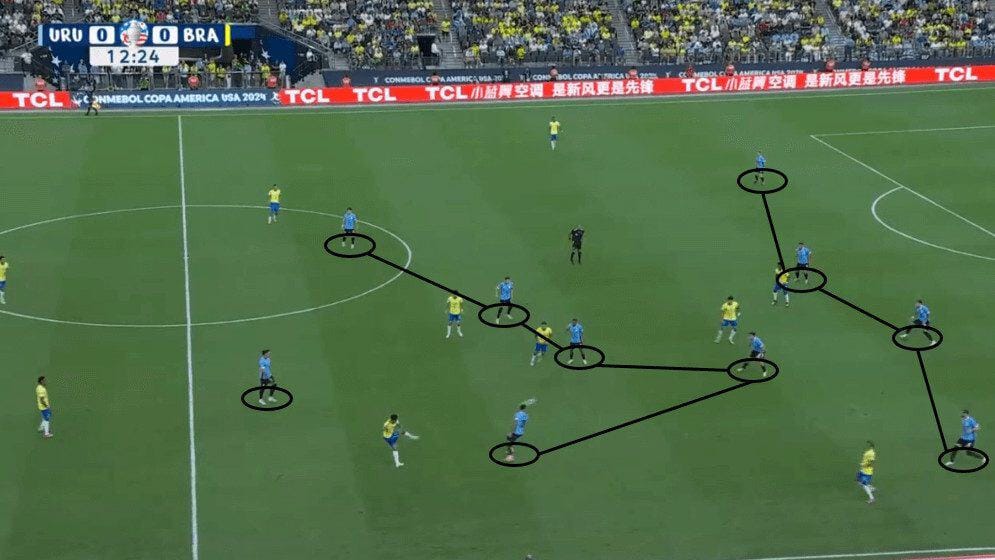
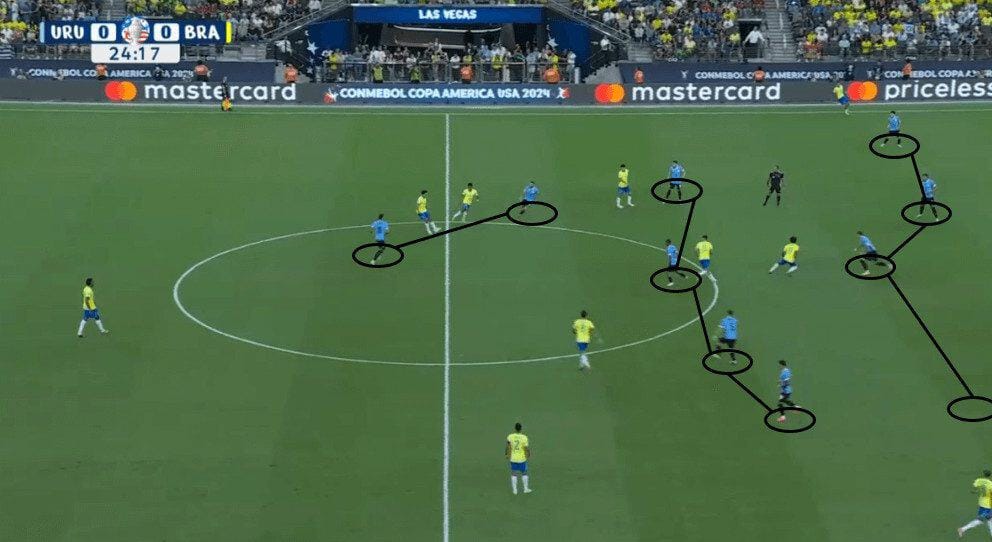
Colombia out of possession
Colombia relies on work rate just like Uruguay. One of their wingers will often move into the striker position when they want to defend in a classic 4-4-2 mid-block. Here, James Rodríguez and Luis Díaz are moving into striking positions to create the first defensive block. In image 2, Luis Díaz and another player form that initial defensive block. Colombia plays with fluidity: if one player can’t help the defensive structure, another can provide that support, which is crucial for maintaining compactness and discipline.
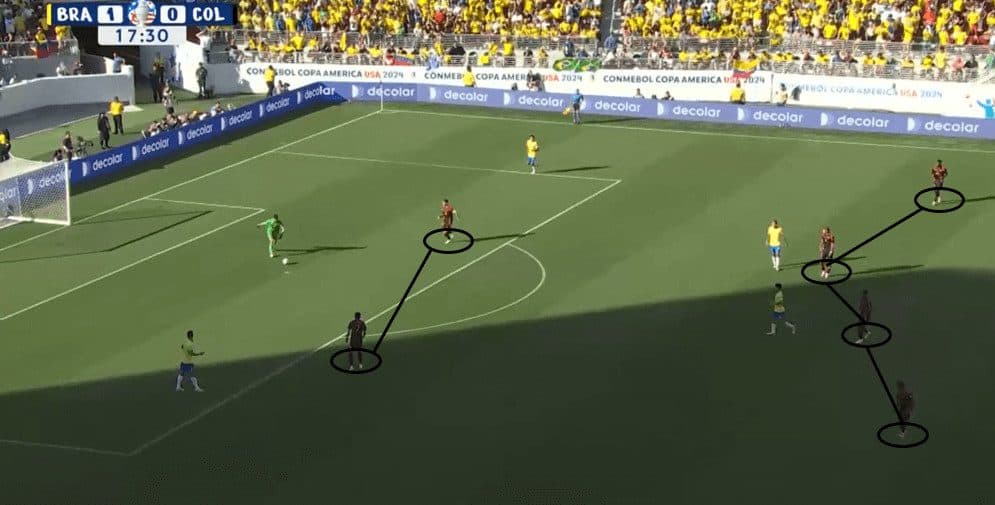
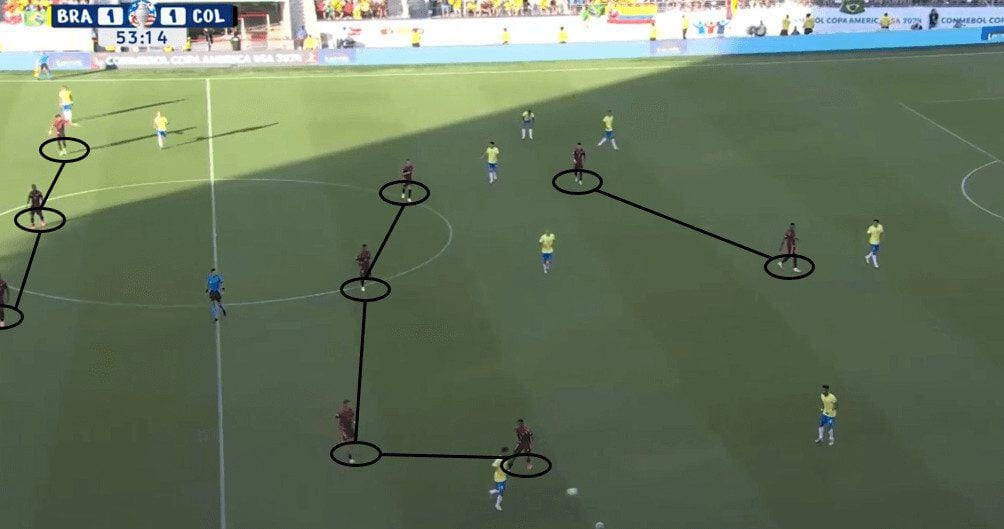
Uruguay in-possession
In possession, Uruguay likes to attack in a 3-4-3 structure, with extremely high and wide fullbacks. In the image below, we can see this attacking tactic against Panama earlier in the group stage. Keep in mind that Colombia like to defend in a 4-4-2, in the image below we see Panama in a 4-4-2 structure as well, Uruguay will be comfortable playing a team in such structure based on how the match went against Panama.
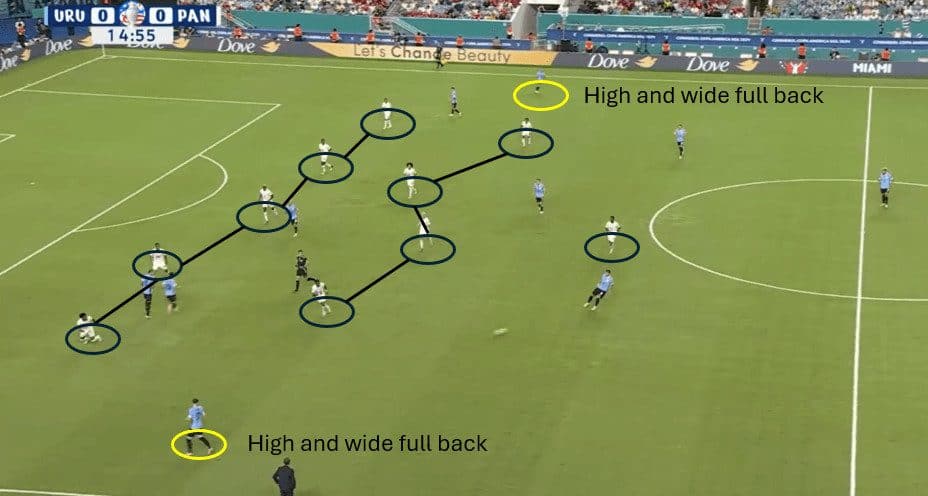
In terms of build-up play, the strategy involves Federico Valverde and Manuel Ugarte dropping back into a double pivot to function as deep-lying playmakers. This tactic leverages the exceptional skills of these two midfielders, who are technically proficient and highly intelligent in facilitating the build-up play. After receiving the ball, the deep-lying playmakers will look to advance play by moving the ball forward, supported by high wingbacks who push up to add numbers in attack.
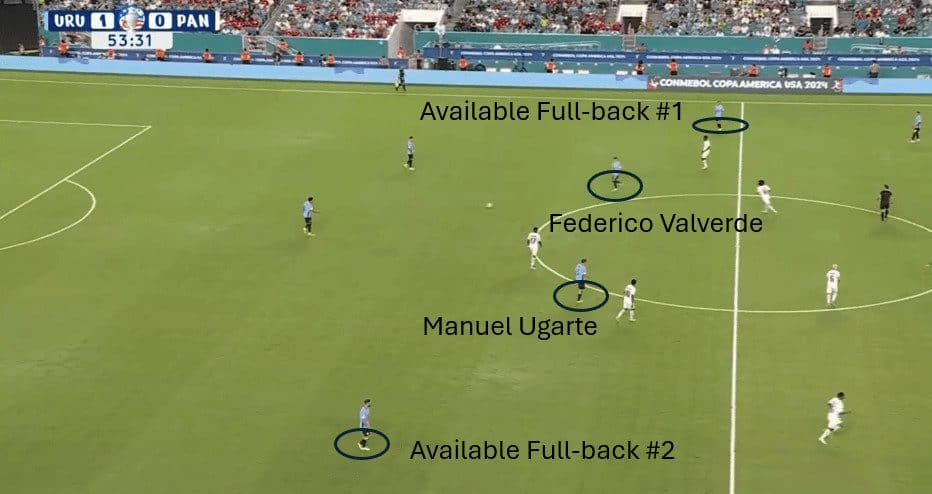
Colombia in-possession
In the attacking phase, Colombia likes to play with fluidity across its attacking line, giving their players more freedom in their roles. Colombia prefers to attack centrally rather than using the wide zones of the pitch. Their star wingers, James Rodríguez and Luis Díaz, often invert and attack as essentially three strikers during certain moments of the match.
We can also see their wingers moving into attacking midfielder positions to help progress the ball forward, as they are the best players technically on the team. This approach not only allows their best players to be on the ball for progression but also creates spaces for the fullbacks to exploit, as seen in the image below.
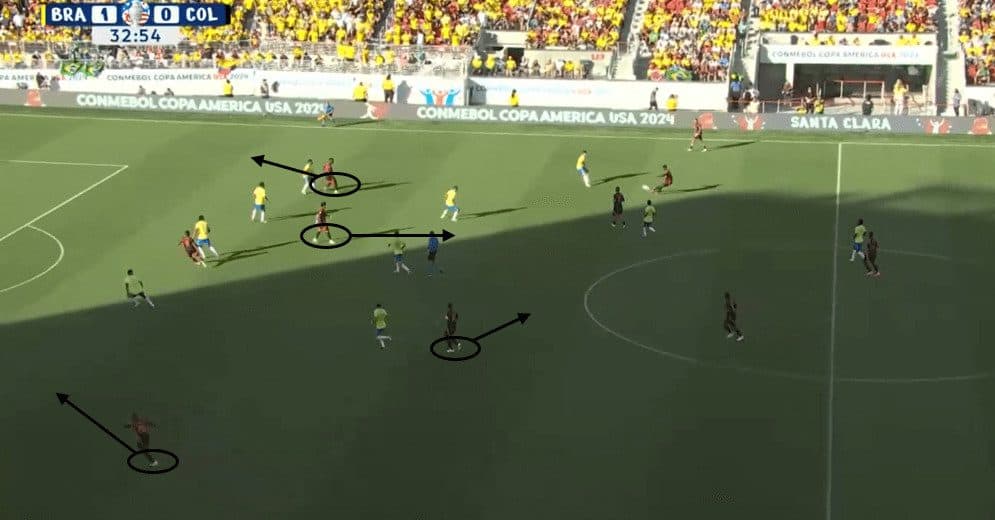
In terms of build-up tactics, Colombia likes to start with a three-back formation and have their three midfielders drop into deep roles. They aim to invite the opponents into a man-marking press while their midfielders act as deep-lying playmakers. If the press is successful, they quickly play wide to their wingers or wingbacks with long passes. If not, they progress the ball using a three-man triangle in front of the three-back formation. Essentially, they use a 3-3-4 or 3-3-2-2 build-up, with two attacking midfielders in front of the three midfielders and two wingers or dual strikers, a tactic commonly seen in German teams.
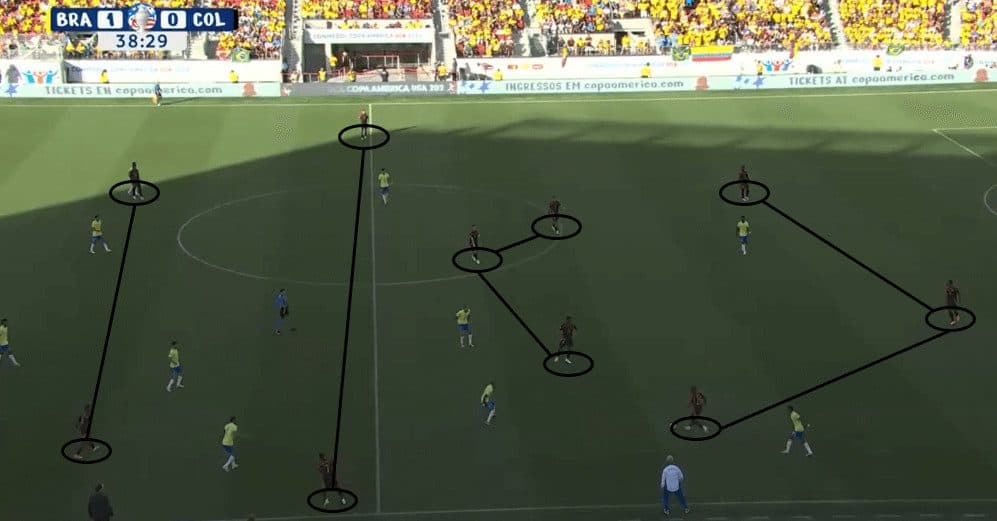
Standout players
Uruguay star – Federico Valverde
Federico Valverde is an extremely versatile and tireless midfielder. He influences the game on both ends, providing his team with defensive solidity and a creative spark. His presence has been a key factor in Uruguay’s success, helping control the midfield battle and driving Uruguay’s attack forward in this match.
In the most recent match against Brazil, Federico Valverde played the full 90 minutes and led the team in tackles with three, winning three out of five attempts. Two of these tackles were crucially made in the defensive third and one in the middle third, showcasing his defensive work rate. Offensively, he made a significant impact by creating one clear chance, attempting seven long balls, completing six, and making six passes into the opponent’s final third. His influence on the game was evident through his 58 touches, constantly being involved in play and pushing Uruguay forward at every opportunity.
Additionally, his six recoveries demonstrated his relentless work rate and ability to regain possession, making him an indispensable asset in Uruguay’s midfield against Brazil. Notably, Brazil was the more dominant team in this match. Having received a red card in the 70th minute, Uruguay played more defensively, which explains Valverde’s lower attacking threat than usual.
Examining Valverde’s heatmap against Brazil, we can see just how much ground he covers. In image 1, his heatmap shows intensity in almost all zones of the pitch, predominantly on the right side but spanning both his team’s half and the opponent’s half. To fully appreciate Valverde’s dominance across the pitch during the 2024 Copa America campaign, image 2 displays his full tournament heatmap.
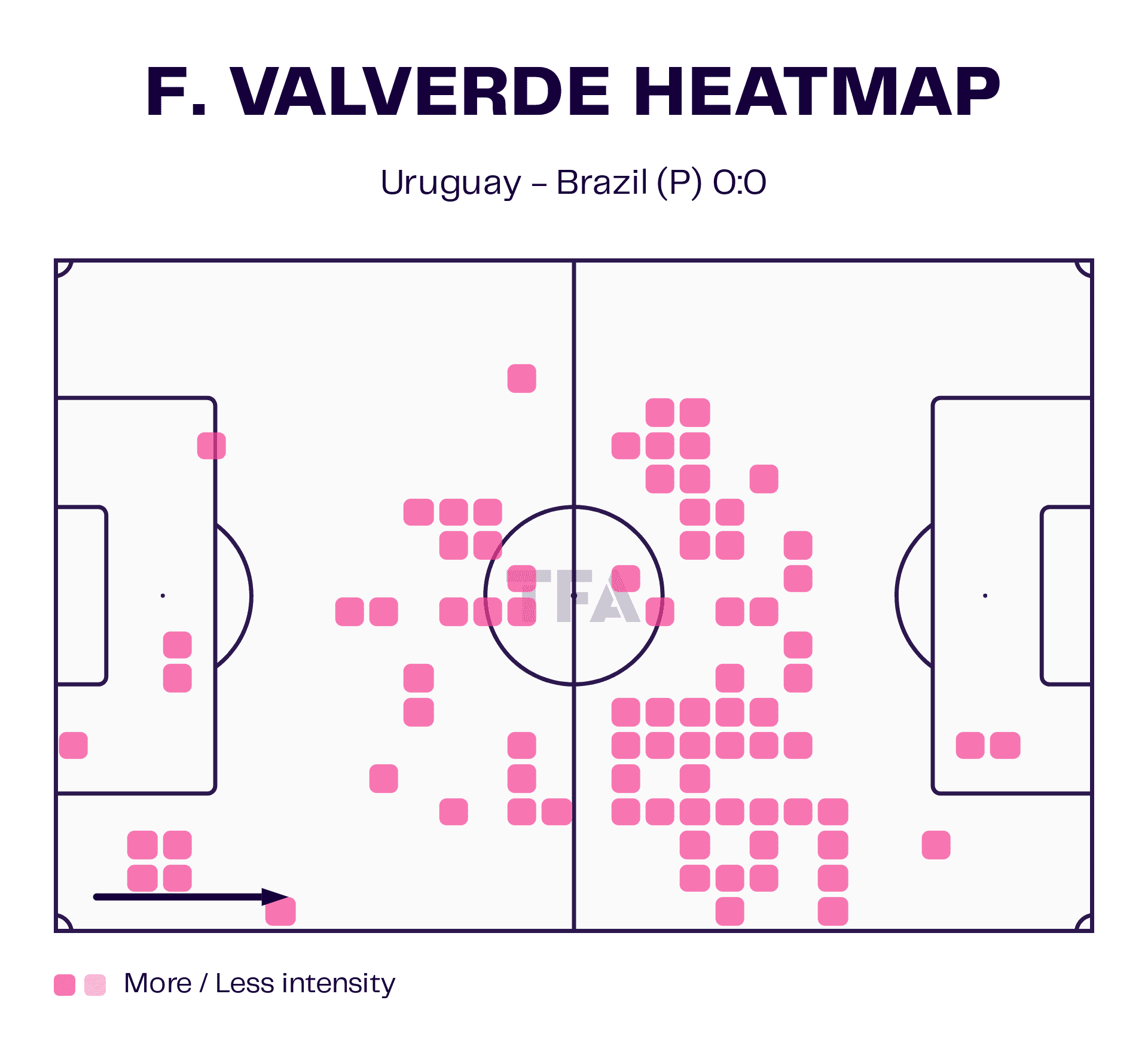
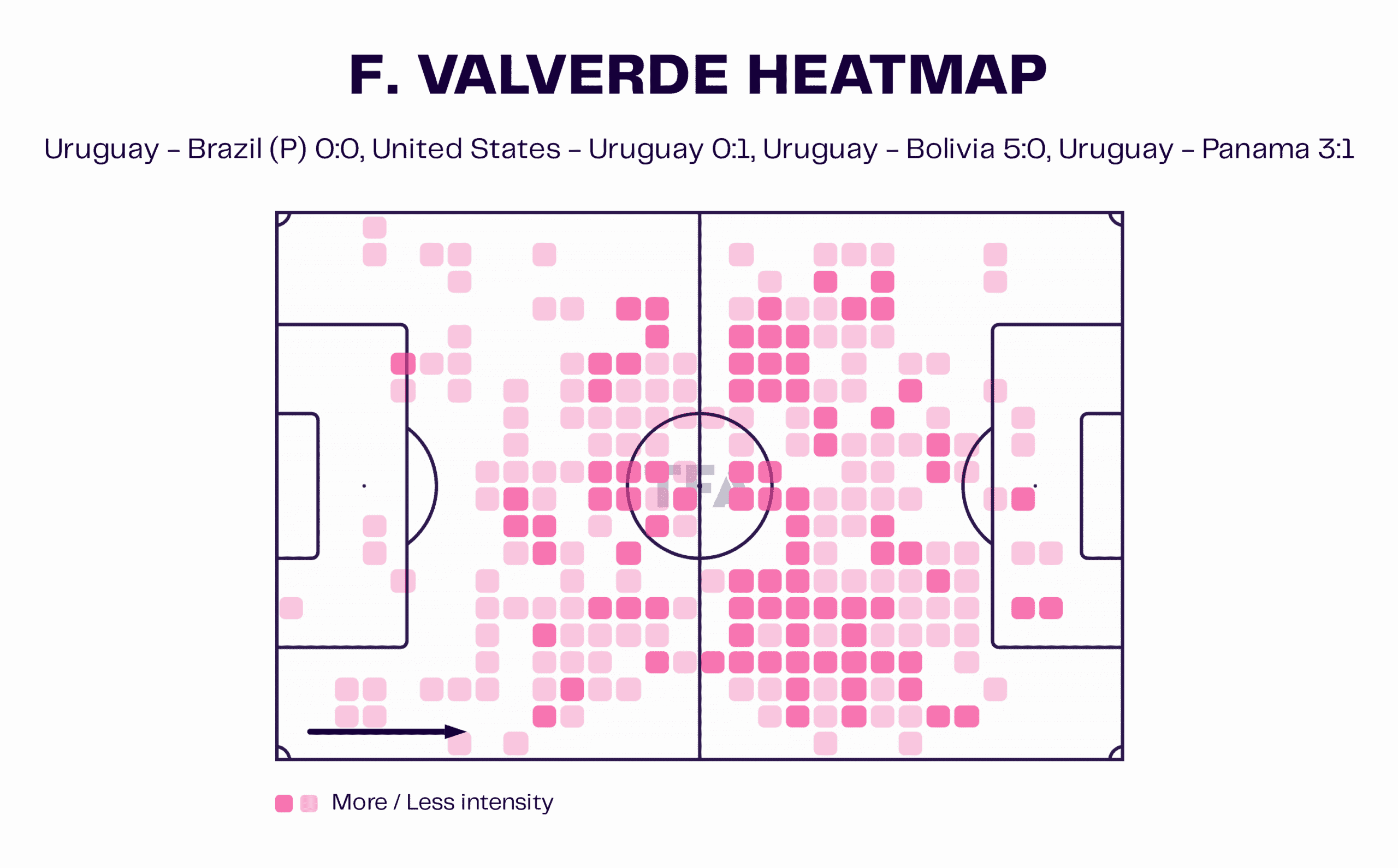
Federico Valverde’s passing map from Uruguay’s recent matches, including the game against Brazil, illustrates his ability to distribute the ball and push his team forward effectively. The map highlights Valverde’s proficiency in delivering progressive passes, with numerous successful attempts originating from both central and right-sided positions. His ability to penetrate the opponent’s defensive lines is evident, as he consistently executed passes that advanced into the penalty area.
These progressive passes showcase his vision and accuracy and underline his crucial role in orchestrating Uruguay’s offensive play. Throughout the tournament, this visual progressive pass map demonstrates that Valverde has been a critical player in the build-up for Uruguay and a significant chance creator in the final third.
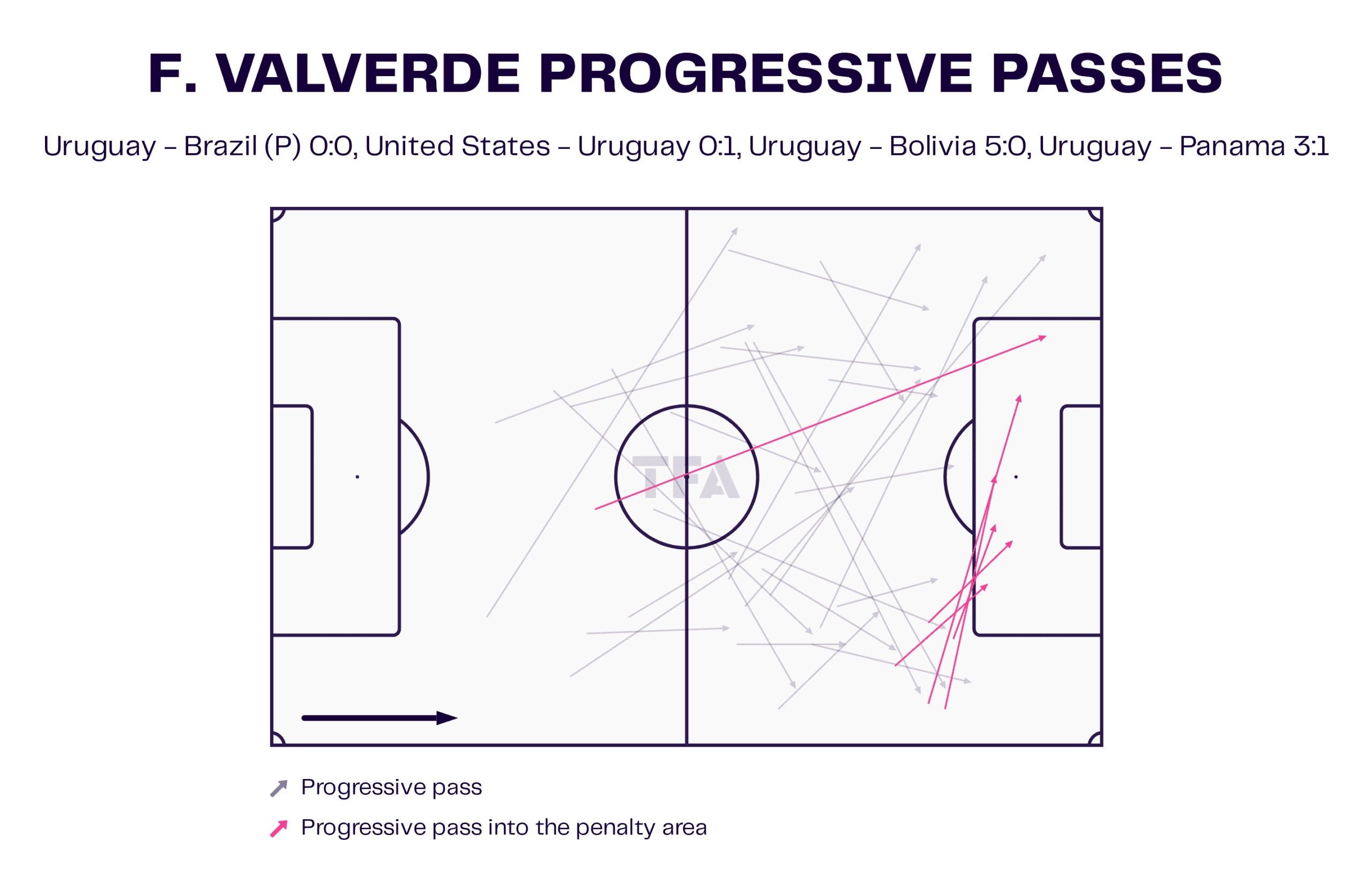
We urge you to take pure statistics like progressive passes with a grain of salt. Among the majority of statistical visuals, progressive passes is one of the few metrics that can effectively measure performance without additional context. However, statistics like chances created, key passes, and big chances created do not necessarily capture real creativity; instead, they primarily reflect good decision-making in the final third.
Colombia star – James Rodríguez
James Rodríguez has reignited his stellar career during the 2024 Copa America, becoming the first player ever to contribute to three goals in the first half of a single Copa America game. He has scored 1 goal and provided five assists so far in the tournament, earning 4 out of 4 Man of the Match performances. He is already a strong contender for Player of the Tournament, and with Colombia now unbeaten in their last 27 matches, they are serious contenders to go all the way.
James Rodriguez’s performance against Panama was impressive despite being on the field for only 72 minutes. He achieved an 82% long pass rate, successfully completing 9 out of 11 long passes. Rodriguez was pivotal in creating scoring opportunities, making three key passes and delivering one pass into the opponent’s final third. His vision and accuracy were further highlighted by five progressive passes and one precise pass into the penalty box. Additionally, he contributed to the attack with one carry into the final third and managed to stay actively involved with 45 touches throughout the match.
Many people may be wondering what type of role James Rodríguez is playing in this Colombian team. Is he playing as a number 10 or as a winger? The truth is, he’s playing a bit of both. James Rodríguez has been playing as a right winger with the freedom to roam into central areas but has gained more responsibility compared to his previous club days. The Colombian playing style we discussed earlier involves their wingers dropping into defensive positions and cutting passing lanes. Below, in the heatmap for the quarterfinal match against Panama, we will see intensity on the right wing (his natural position), as a number 10 (his roaming responsibility), and in a defensive position (forced by the team’s playstyle).
In image 1, we see the heat map for James Rodríguez against Panama, and in image 2 is his heat map for the entirety of the 2024 Copa America campaign. You can notice the high intensity in the right-back area of the field, as well as the central areas where he flourishes as a creative outlet.
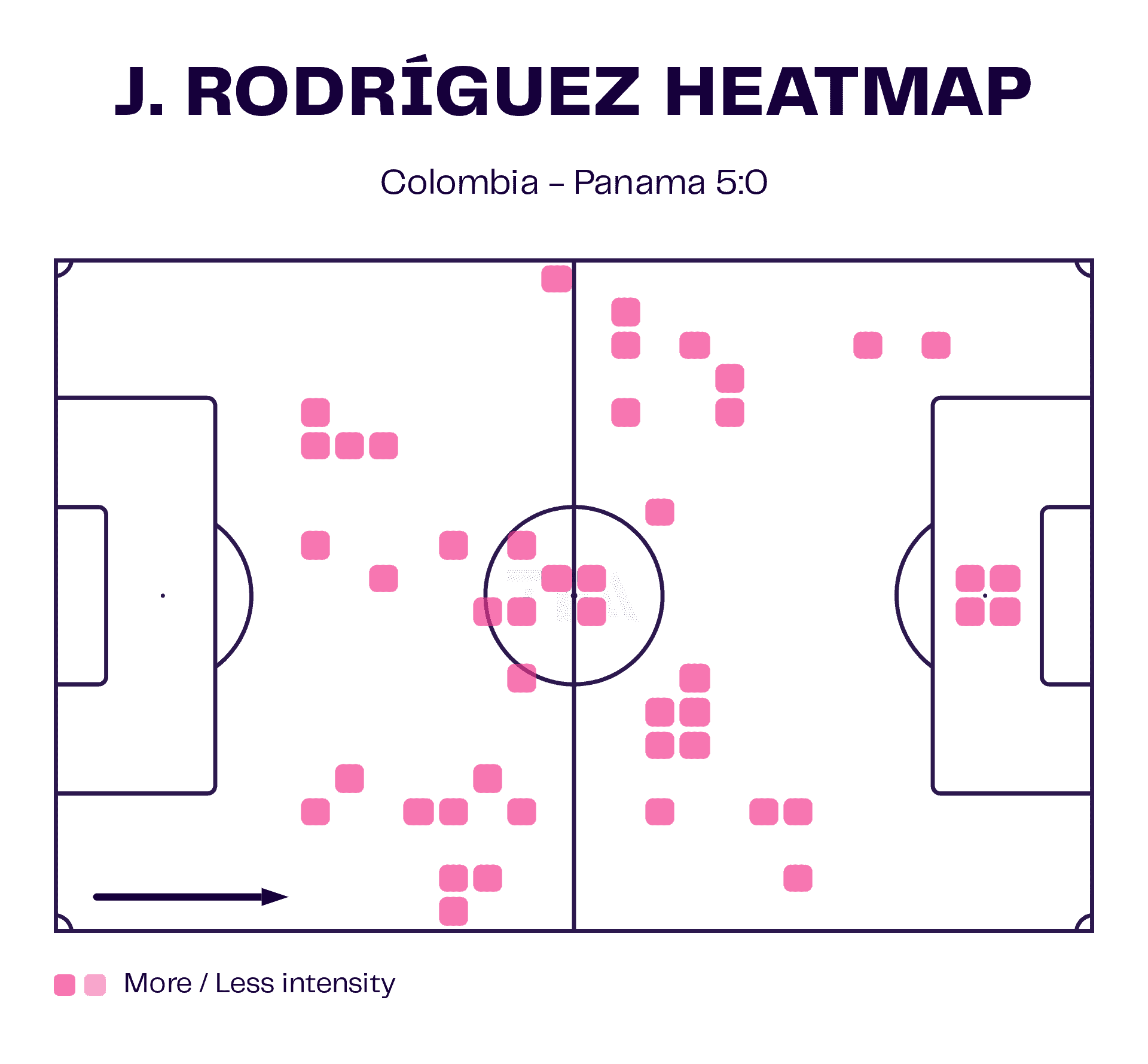
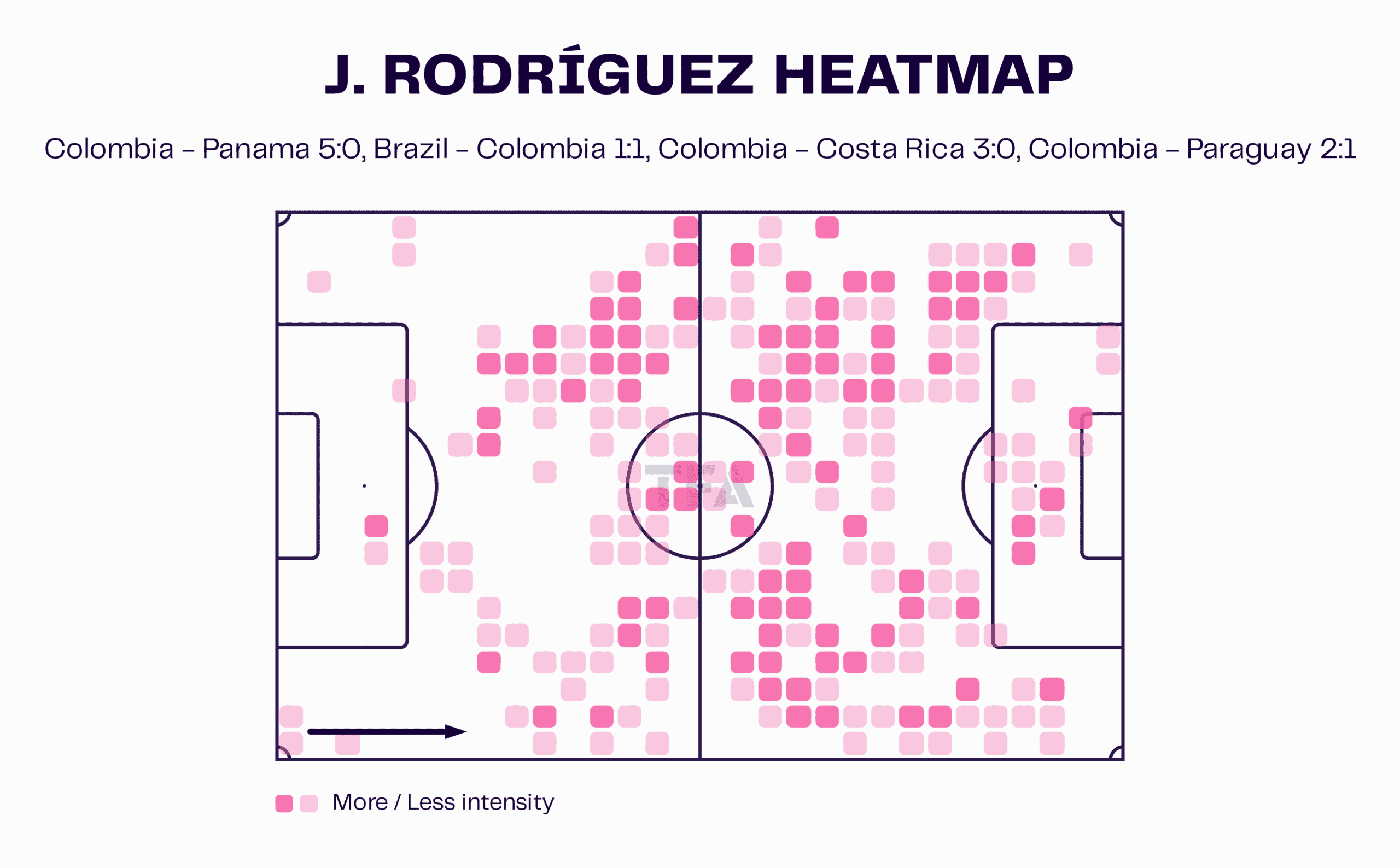
Winger actions are valuable because they highlight a player’s offensive involvement, showcasing dribbling success, passing accuracy, and contributions to goal-scoring opportunities. For a player like James Rodríguez, this map effectively illustrates his influence on the game and his ability to create chances from the wide zones of the pitch.
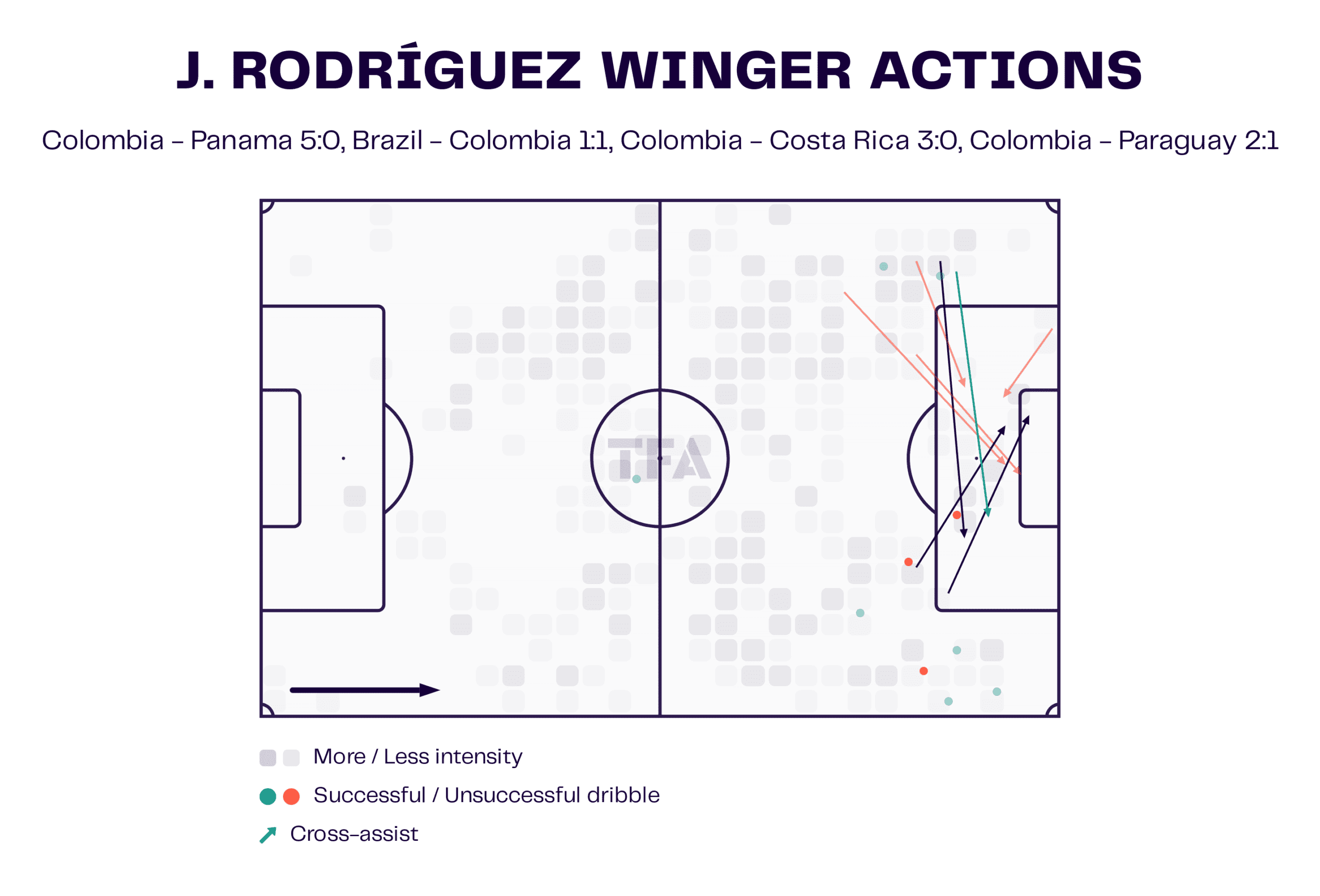
James Rodríguez having five assists is extraordinary, especially considering he has only played 4 out of the possible six games so far. Shot assists are valuable for highlighting a player’s ability to create goal-scoring opportunities for teammates. This graphic shows James Rodríguez’s contributions with precise assists leading to shots. It indicates his vision and passing accuracy, evidenced by five assists and an expected assist (xA) value of 1.37, demonstrating his crucial role in the attacking phase as well.
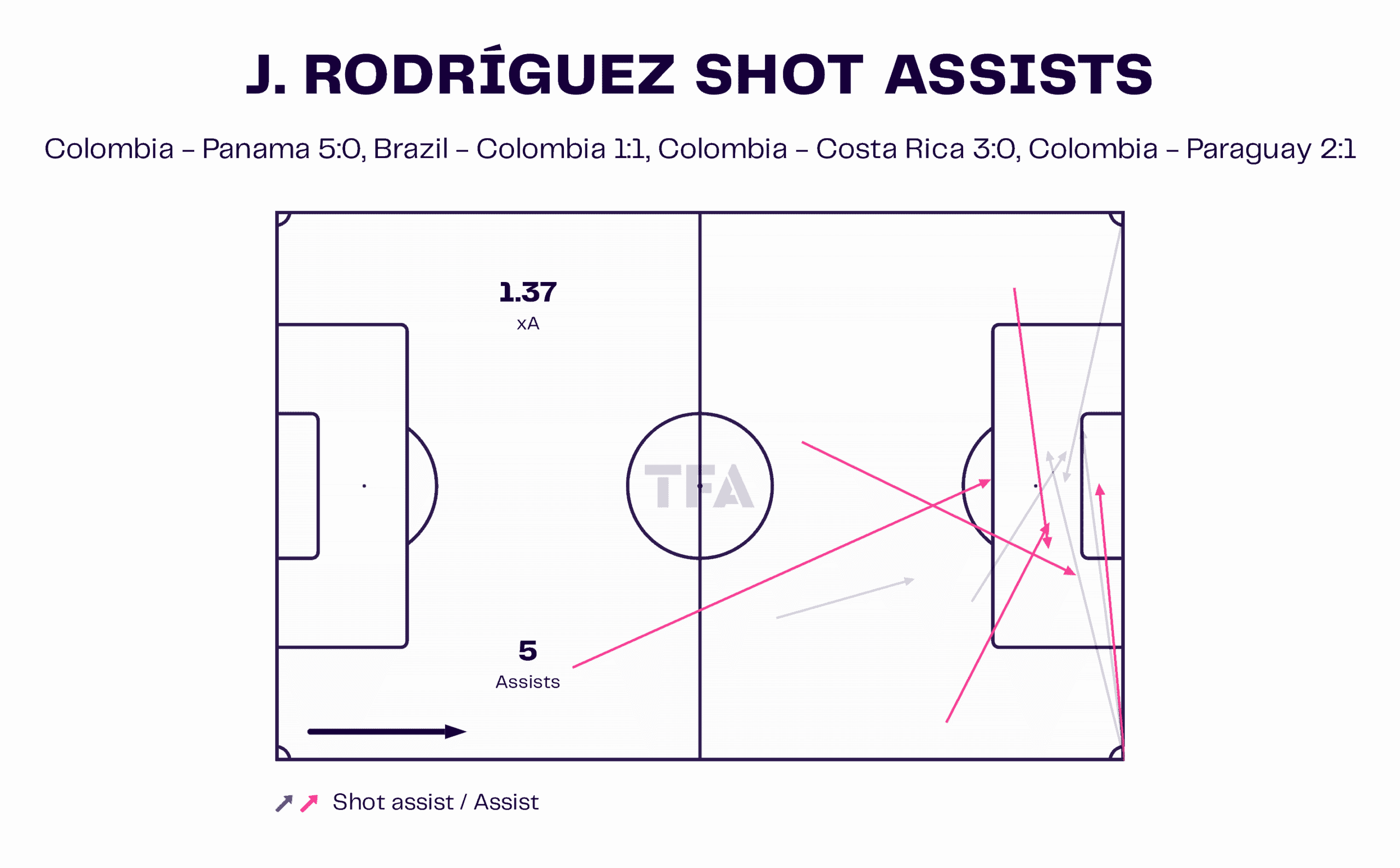
Conclusion
Football fans can expect a thrilling and intense encounter in the upcoming Copa America semi-final match between Colombia and Uruguay on July 10th, 2024. Uruguay, under Marcelo Bielsa, will showcase their signature high-pressing and man-marking style, making the game physically demanding and fast-paced. Bielsa’s dynamic formations and focus on positional play will aim to exploit Colombia’s weaknesses.
On the other hand, Colombia, led by Néstor Lorenzo, will rely on their structured defence and tactical discipline, coupled with swift counter-attacking play. Lorenzo’s emphasis on player adaptability ensures Colombia’s approach can shift fluidly to match Uruguay’s tactics with their best players. Key players like Federico Valverde for Uruguay, known for his versatile and tireless midfield performance, and James Rodriguez for Colombia, with his impressive offensive contributions and creative play, will be pivotal. The match promises to be a battle of tactical prowess and individual brilliance, with both teams aiming for a spot in the final.





Comments